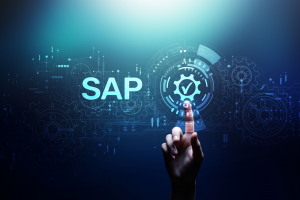SAP S/4HANA is an intelligent real-time ERP system allowing businesses to optimize their processes and be future-ready. It will help companies use the latest technologies to achieve a high degree of automation. Unlike preceding ERP systems, SAP S/4HANA offers quick access to all data and analysis, enabling users to make data-driven decisions.
Migration to SAP S/4HANA can evoke several challenges. This requires a thoroughly planned changeover. The approach and steps to implement the migration depend on the actual and target architecture of the company.
SAP and its Offerings
Since its foundation in 1972, SAP, initially called System Analysis Program Development, has always set globally high standards in developing Enterprise Resource Planning (ERP) software. SAP, the software, and its modules are created to streamline businesses and their processes. SAP is well suited for any business, is flexible, and can help organizations manage almost all of their departments in a simplified and centralized way.
SAP ECC (ERP Central Component), or simply SAP ERP, is one of SAP legacy applications initially designed to operate on a third-party database. As an on-premises ERP system, the software integrates digital information created in one vertical of a business with data from other verticals in real-time. Practically this means an update in one area of the business, such as sales, will trigger updated information in other relevant business areas, such as inventory. This gives an integrated view of enterprise resources that the managers can leverage to make data-driven decisions on optimizing the core business processes.
With all that data captured through the ERP systems, a need was felt for a data platform to help manage analytical, transactional, and application development. SAP HANA, released in 2010, was created so that companies can access and react to the latest, near real-time data instead of static quarterly reports. An in-memory database and columnar in nature, SAP HANA is designed to speed up SAP apps and business processes. The simplified data structure offered by SAP HANA improved performance to increase user productivity, provide real-time visibility, and take advantage of analytics.
What is SAP S/4HANA?
In 2015, SAP rebuilt SAP ECC to create SAP S/4HANA, building on the advantage of SAP HANA’s performance and data analytics capabilities. While SAP ECC can run on a third-party database, S/4HANA exclusively runs SAP HANA.
SAP S/4HANA’s unique architecture makes it run in-memory, with data stored in columns. This allows for faster, near to real-time analytics and computing capabilities. It does more than just record data, focusing on providing active decision support to the end-users in near real-time— data-driven decision-making.
Advantages of SAP S/4HANA
SAP S/4HANA is being considered as a revolutionary SAP innovation that has drastically redefined ERP systems. With innovative technology such as machine learning and predictive analytics, SAP S/4HANA has emerged as a competitive data management tool that can prepare organizations for a digital future. Not only does it manage data, but it can also optimize and automate business processes to make organizations more competitive.
Some advantages of SAP S/4HANA are –
- Easy to Use: The new Fiori interface (Fiori 2.0) offers a modern design with a simplified, personalized, and innovative user experience. It provides users with faster access to important information. The design is intuitive and simple, which promotes efficient work regardless of device or deployment.
- Flexible: Its availability in various forms and payment models makes it cost-effective. It brings on board the ability to incorporate all the analytical and transactional capabilities of multiple systems into one platform. Customers can opt from an on-premise version, a hybrid model, or the cloud version during migrations based on their requirements and budget.
- Innovative: The in-memory database allows users to access their data in real-time. This improves performance as the planning, execution, report generation, and analytics are based on live data., The simplified data model reduces the size of the database and also avoids redundancy. It enables organizations to perform ad hoc analyses and transactional procedures using a single system.
Why is Migration Required?
Adapting to the latest and innovative technology solutions helps organizations stay relevant. SAP S/4HANA, with its innovative features and functionality, is assisting organizations in achieving growth through faster response and better performance.
As a platform that can grow and adapt, SAP S/4HANA assists the migrating organizations in expanding the business, entering new markets, and creating new warehouses or production facilities. Migrating to SAP S/4HANA is beneficial for a company as it increases the value by positively improving the business processes, leveraging the data for enhanced insights, and driving business agility.
Moreover, come 2027, SAP will discontinue support for the SAP R3 ERP, which it now considers its legacy system. So the right time to migrate to the SAP S/4HANA ERP is now.
The Build-Up to Migration
The SAP S/4HANA Migration process means migrating from the ECC or SAP HANA platform to the S/4HANA platform, which works on on-premise and cloud technology. To prepare for the migration, organizations should consider the following steps:
- Assess: Perform a technical and functional assessment. Analyze data relationships and core business processes driving end-to-end business, including integration of non-SAP applications.
- Explore: Improve data quality and trustworthiness and integrate it into the core processes. Map your business processes, define your business priorities and pain points, and explore custom development possibilities.
- Convert: Time to make the actual move. Implement your plan to transform and expand the business model.
Approaches to Migration
While finalizing the migration plan, one crucial decision to make is that of choosing the right approach. Now there is no single or one-size-fits-all solution. Looking at the organizational database, platforms, and configuration will help assess the organization’s readiness and finalize the most suitable approach.
Here, we analyze each of the three methodologies:
Greenfield Approach
An entirely new implementation of SAP S/4HANA requires a Greenfield approach. Since everything needs to be done from scratch, the process is seemingly time-consuming and can appear tiresome. On a positive note, this approach lets organizations redefine and simplify their business processes.
Brownfield Approach
For existing customers operating on SAP ECC, SAP recommends taking the brownfield approach or route. This approach is also known as system conversion, wherein an organization moves the complete system and business process to the new S/4HANA platform. This approach lets organizations run their business with less disruption and without changes on the operational aspect as it is more of technical system conversion. The risk of possible issues arising on the technical side can be mitigated by utilizing the conversion tools provided by SAP.
Landscape Approach
Taking the landscape approach lets businesses convert selective parts of the business process instead of complete system conversion. Organizations can migrate to SAP S/4HANA selectively or unite the business landscape into one global system. A business can first select the best returns process through this approach, and the rest can follow suit.
Stages of Migration
Based on the approach, the actual migration plan will be drawn for a successful transformation. The steps involved according to the approach are –
Greenfield
The SAP Activate methodology best describes the steps required to carry out a greenfield migration.

- Discover: Identify the value of the business and then develop the roadmap and strategy.
- Prepare: Initiate the project, start work on the final project plans, prepare the team.
- Explore: Carry out the scope evaluation process and a Fit/Gap analysis to choose the best solution per organizational requirements.
- Realize: Focus is on the realization process of the business requirements defined in the earlier phase, including system configuration settings, data migration, etc.
- Deploy: Set up of production environment. Once ready, cutover activities are to be performed for business operations to move to the new system.
Brownfield and Landscape

The migration process is divided into two phases and then subdivided:
Preparation Phase
- System Requirements & Planning: Assess and analyze the existing system and then define the best possible solution for migration.
- Conversion Pre-Check: Check add-ons or business functions for compatibility to ensure their technical conversion into S/4HANA. The Simplification Item check provided by SAP helps to identify the mandatory steps before converting the system.
- Custom Code Migration: Check the current system’s custom code against S/4HANA compatibility, especially if there are enhancements in it.
Realization Phase
- System Installation: Start the conversion to SAP S/4HANA, including database migration.
- Follow-On Activities: Once through with the technical conversion, the customized settings must be migrated. Organizations need to check for Data Consistency. SAP S/4HANA collects all appropriate components from Financial Accounting (FI) and Controlling (CO) into one data pool, called the Universal Journal. To ensure that data has been correctly merged into the Journal, organizations must perform reconciliation between the accounting components.
- Iteration Testing: Test iterations must be performed after all customizations and data migrations have been performed to ensure that the system runs smoothly, correctly, and efficiently.
Conclusion
In order to prepare for the migration to SAP S/4HANA, organizations should catalog their metadata, create governance of the master data, and finally extract and transfer them to the migrated environment with an improved process.
Taking the final call to migrate to SAP S/4HANA is a tough decision that will ultimately benefit the business and add overall value. For organizations already using SAP EC or HANA, moving to SAP S/4HANA is just a matter of time when the support for the current system ceases. Moving ahead with the migration now will prove to be a timely decision to unlock the potential of SAP investments.
About the Author:

A senior management professional with 3 decades of expertise in driving business strategy & business operations and a strong understanding of value chain at multiple industry verticals like Telecom, BFSI, Media & Entertainment, Manufacturing & eCommerce. Vinod has always been a synonym for customer centricity, dependable operational excellence and exemplary leader delivering corporate objectives including aggressive organic & Inorganic business growth.

 December 6, 2021
December 6, 2021 Vinod Pahlawat
Vinod Pahlawat














































